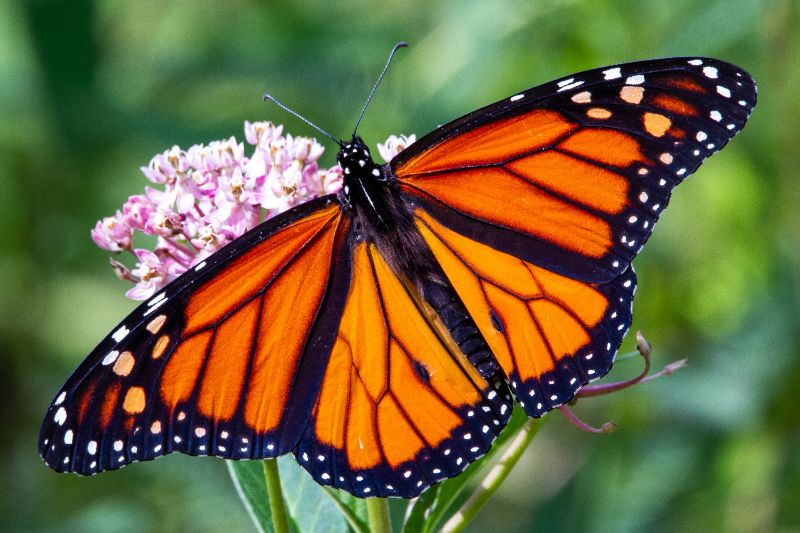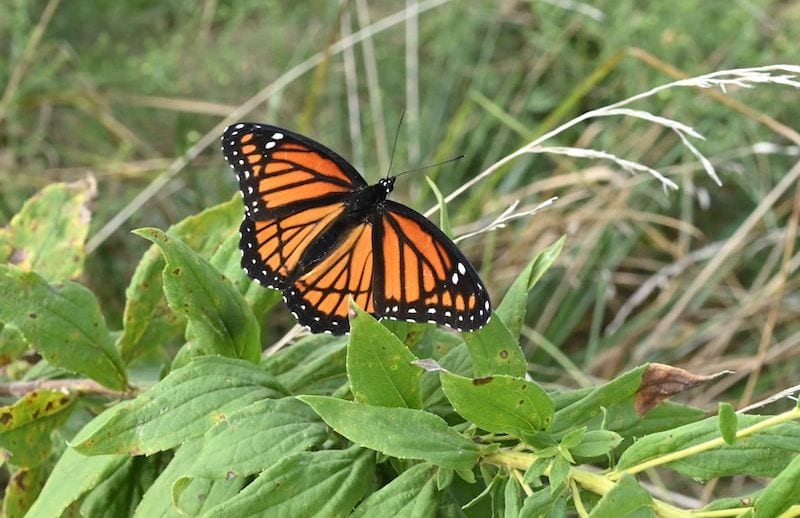11 Most Common Types of Butterflies in Florida (With Pictures)
-
Pete Ortiz
- Last updated:

The name Florida is derived from old Spanish, meaning flowery or full of flowers. It is no wonder, then, that the state is home to an abundant population of different butterflies. There are hundreds of unique butterfly species that call Florida home, including many migratory butterflies that come to the state during the winter months. Even with a large volume of unique butterfly species that frequent Florida there are some that are more common than others.
These are eleven of the most common types of butterflies that you can find in Florida today. Keep your eyes peeled next time you visit the Sunshine State for some of these unique beauties.
The 11 Types of Butterflies in Florida
1. Zebra Longwing

| Scientific name: | Heliconius charitonius |
| Color: | Black and white |
| Type: | Heliconian |
The zebra longwing is the state butterfly of Florida. It can be found throughout the state and is prized by native Floridians for its iconic appearance. The zebra longwing has a solid black body broken up by white or yellow stripes. The zebra butterfly has a long and lazy flying pattern that is both graceful and distinctive. One of the reasons Florida named the zebra longwing the state butterfly is because of its high population in Everglades National Park. The Everglades is one of Florida’s most important natural features, and the zebra longwing makes its home within the park. The populations of zebra longwings are the largest in southern Florida, but they can be spotted anywhere year-round.
2. Zebra Swallowtail

| Scientific name: | Eurytides marcellus |
| Color: | Black and white |
| Type: | Swallowtail |
The zebra swallowtail butterfly is similar in appearance to the Florida state butterfly, the zebra longwing. However, these butterflies are distinctive thanks to their split wings and long trailing tails. The long tails and trails make these butterflies a crowd favorite to spot. It is even the state butterfly of Tennessee. These insects have a large range that stretches from southern Canada all the way down through Florida. Zebra swallowtails have a strong black-and-white pattern that is reminiscent of a zebra. These butterflies are easy to spot in rural areas, but they are not as common in urban and suburban areas.
3. Giant Swallowtail

| Scientific name: | Papilio cresphontes |
| Color: | Black and yellow |
| Type: | Swallowtail |
The giant swallowtail is the largest butterfly species in North America. It has a large wingspan that boasts black and yellow patterns. It is easy to spot in flight due to its large size. It can be found throughout the eastern half of the United States, with some pockets also present west of the Rocky Mountains. Giant swallowtail butterflies are a joy to see in nature, but their caterpillars can be a major pain. Since the giant swallowtail is so large, it produces large caterpillars that have the ability to heavily damage gardens and crops. The caterpillars have a unique pattern that looks like bird droppings to keep curious predators away. If you spot giant swallowtails around your house, you might also have to deal with a swallowtail caterpillar invasion the next season.
4. Painted Lady

| Scientific name: | Vanessa cardui |
| Color: | Orange, yellow, and brown |
| Type: | Brushfoot |
Painted lady butterflies are the most widespread and common butterflies in the whole world. They can be found in North America, Europe, Africa, Asia, and Australia. They have the widest range out of any butterfly, and their range includes Florida. Painted ladies have very distinct patterns that include orange, black, and tan accents. The upper side of the wings looks very different from the bottom side of the wings. The bottom of the wings is much tanner and browner than the upper side, but the pattern is the same. In North America, the butterfly used to be called the cosmopolitan butterfly due to its range. Since it is so widespread, this insect has had a variety of different names and titles in different locations and cultures over the years.
5. Gulf Fritillary

| Scientific name: | Agraulis vanillae |
| Color: | Orange and black |
| Type: | Brushfoot |
Fritillary is the name for a butterfly with orange wings with black accents. Hence why this butterfly is named the gulf fritillary. It is a fritillary that is native to the Gulf states. These butterflies have bright orange wings with stripes and a few spots. The pattern is different enough from monarchs that they are not often confused like some other species. Gulf fritillaries can be found throughout the southeastern United States but have their largest populations in Texas and Florida along the humid coastlines that border the Gulf of Mexico. This butterfly is also sometimes called the passion butterfly. It was assigned a scientific name in the 18th century.
6. Monarch Butterfly

| Scientific name: | Danaus plexippus |
| Color: | Orange, black and white |
| Type: | Milkweed |
Monarch butterflies are perhaps the most recognizable species of butterfly in the United States. Their large and stately shape, combined with their striking orange, black and white pattern, are well known. The appearance of the monarch butterfly has endeared it to generations of Americans. Monarch butterflies can be found throughout Florida. Florida has over a dozen cities that participate in the Monarch City, USA campaign to help foster monarch butterfly populations and health. Monarch butterflies are a type of brushfoot butterfly, and they absolutely adore milkweed. Monarch butterflies are also sometimes referred to as the common tiger butterfly.
7. Viceroy Butterfly

| Scientific name: | Limenitis archippus |
| Color: | Orange, black and white |
| Type: | Brushfoot mimic |
You have likely seen a viceroy butterfly without even realizing it. These butterflies look almost identical to the more famous monarch butterfly. Viceroy butterflies are considered mimics because their appearance so closely matches that of the monarch butterfly. You can tell the difference if you spot the distinct black line that is present on the viceroy’s wings but not the monarch’s. When these butterflies are young caterpillars, they look completely different. Viceroy butterflies are also found throughout Florida alongside the monarchs making it hard to distinguish one from the other.
8. Queen Butterfly

| Scientific name: | Danaus gilippus |
| Color: | Orange, black and white |
| Type: | Brushfoot |
The queen butterfly is yet another insect that looks similar to the monarch butterfly. All of these butterflies carry a similar naming convention – monarch, queen, and viceroy – which lets you know that they are similar in appearance. The queen butterfly is sometimes confused for a monarch butterfly at a distance, but when you get up close, you can see numerous white spots on the wings of the queen butterfly that easily distinguishes it from viceroy and monarch butterflies. Queen butterflies can be found throughout the Florida peninsula year-round. Queen butterflies are a type of common brushfoot which are the most numerous types of butterfly found in Florida. They frequent well-kept gardens, especially those that have butterfly-attracting plants.
9. Cloudless Sulphur

| Scientific name: | Phoebis sennae |
| Color: | Green and yellow |
| Type: | Yellows |
The cloudless sulphur butterfly is one of the most striking and common butterflies found in Florida. It is especially prevalent during the autumn months. This butterfly moves south ahead of colder weather that starts to appear up north after the end of summer. These butterflies are part of the whites and yellows family of butterflies which has the scientific name Pieridae. These insects are distinguishable by their solid greenish-yellow coloring. It gets its name from the color of its wings, which looks similar to that of sulfur. (The American spelling of sulfur contains an f, while the British version contains a ph. This butterfly retained its British spelling for the name.) The wings are without blemish and contain no spots hence the moniker cloudless. Look out for these butterflies during the fall and early winter months in Florida.
10. White Peacock

| Scientific name: | Anartia jatrophae |
| Color: | White, orange, and black |
| Type: | Brushfoot |
The white peacock butterfly is one of the most beautiful examples on this list. It has an impressive wingspan that sports a very striking pattern. The name is derived from the fact that the spots and swirls on the butterfly’s wings look similar to that of a peacock’s plumage. Once you recognize these beautiful insects, they become easy to spot and identify. These butterflies are common throughout the United States and also range throughout Central America and South America. They thrive in warm tropical climates and frequent aromatic tropical plants. White peacock butterflies deposit their larva into the water that collects inside tropical plants such as tropical hyssop and frogfruit.
11. Florida White Butterfly

| Scientific name: | Appias drusilla |
| Color: | White |
| Type: | Whites |
The Florida white butterfly is a species of Pieridae that can be found in the southern half of the Florida Peninsula. These butterflies have dainty textured wings and smooth white coloring. They can be found in South Florida and the Florida Keys. They are also abundant in the Caribbean as well as the northern parts of South America. This is a tropical butterfly that is unique to Florida. It rarely is spotted anywhere else in the United States, hence the name. Sometimes these butterflies will migrate to the gulf coast of Texas during certain parts of the year, but they are native year-round to the southernmost Florida counties.
Conclusion
If you like butterflies, Florida is one of the best places to be. Florida has dozens of native butterfly populations. There is even an extremely popular butterfly exhibit in Gainesville near the University of Florida. You can spot butterflies of all types, from large elaborate flyers like the white peacock to universal favorites like the monarch butterfly and simple white tropical varieties. Next time you visit the Sunshine State, keep your eyes peeled for some of these common butterfly species. Chances are, you will spot one.
Featured Image Credit: Jennifer Murray, Pexels
Contents


